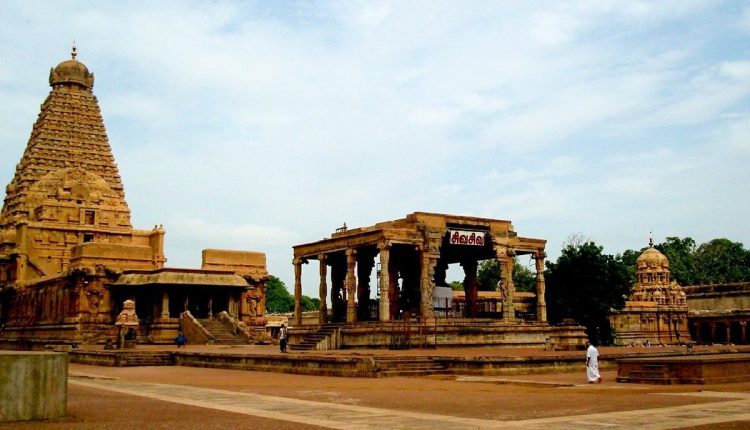estled in the heart of Tamil Nadu, Thanjavur Periya Kovil—also known as the Brihadeeswarar Temple—is not just a religious monument. It’s a living embodiment of South India’s ancient glory, a marvel etched in stone that has stood strong for over a millennium. Built during the reign of Raja Raja Chola I in the 11th century, this temple is an awe-inspiring showcase of artistic vision, engineering prowess, and spiritual depth.
A King’s Dream Carved in Stone
Constructed in just seven years (between 1003 and 1010 AD), the Thanjavur Periya Kovil was the brainchild of one of South India’s greatest rulers, Raja Raja Chola I. This temple wasn’t merely a place of worship; it was his vision of uniting divine power with earthly authority. Built entirely from granite—an astonishing feat considering the region’s lack of granite quarries—it required immense logistical skill to transport and assemble.
The temple tower, or vimana, rises to about 66 meters (216 feet), making it one of the tallest of its kind in the world. Topping it is a single stone weighing nearly 80 tons, believed to have been placed using a sloping ramp technique—an engineering marvel even by today’s standards.
Divine Architecture and Symbolism
Every inch of the temple tells a story. Intricate sculptures, mythological depictions, and carved inscriptions whisper tales from a time when art and devotion walked hand in hand.
One of the most striking features of the temple is its Nandi—the sacred bull that serves as the mount of Lord Shiva. Carved from a single stone and measuring over 13 feet high and 16 feet long, this is one of the largest monolithic Nandi statues in India.
Inside the sanctum, the towering lingam—symbolizing Lord Shiva—is a sight to behold. Unlike many other temples, the inner sanctum of Thanjavur Periya Kovil is spacious and echoes with ancient chants and timeless silence.
A Treasure Trove of Art and Inscriptions
This temple is more than just stone and sculpture; it’s also a precious archive. The outer walls and corridors are adorned with inscriptions in Tamil that provide insights into the political, economic, and social life of the Chola period. These inscriptions include details about temple administration, donations, land grants, and even musical traditions of the time.
The Chola bronze sculptures—particularly of deities like Nataraja—are believed to have evolved and thrived under the cultural patronage that temples like this one offered.
Legacy That Lives On
More than a millennium later, Thanjavur Periya Kovil continues to be a living, breathing space of faith and heritage. It has witnessed the rise and fall of empires, colonial transitions, and modernity—but has never lost its sacred rhythm.
The temple is part of the UNESCO World Heritage Site known as the “Great Living Chola Temples.” Its preservation is a testament to the genius of its creators and the reverence it continues to command.
Festivals and Spiritual Energy
Every year, the temple hosts the Maha Shivaratri festival, attracting thousands of devotees and tourists alike. The rituals are conducted with meticulous detail, echoing centuries-old traditions. The temple’s corridors come alive with music, chants, and the flickering light of oil lamps, creating an atmosphere that is both deeply spiritual and visually enchanting.
Why You Must Visit
Whether you’re a history lover, architecture enthusiast, spiritual seeker, or a curious traveler, Thanjavur Periya Kovil offers an experience unlike any other. It is where history breathes, where every stone has a voice, and where the past continues to shape the present.
Stand beneath its towering vimana, trace your fingers along centuries-old carvings, and feel the pulse of a civilization that reached artistic and spiritual peaks with remarkable foresight and craftsmanship.
Final Thoughts
Thanjavur Periya Kovil is not just a temple—it’s a monument to timelessness. It reminds us of a past rich with vision, faith, and culture. In an age of fleeting trends and momentary attention, this temple stands firm as a reminder of what endures: devotion, art, and the pursuit of something greater than oneself.


Comments are closed.